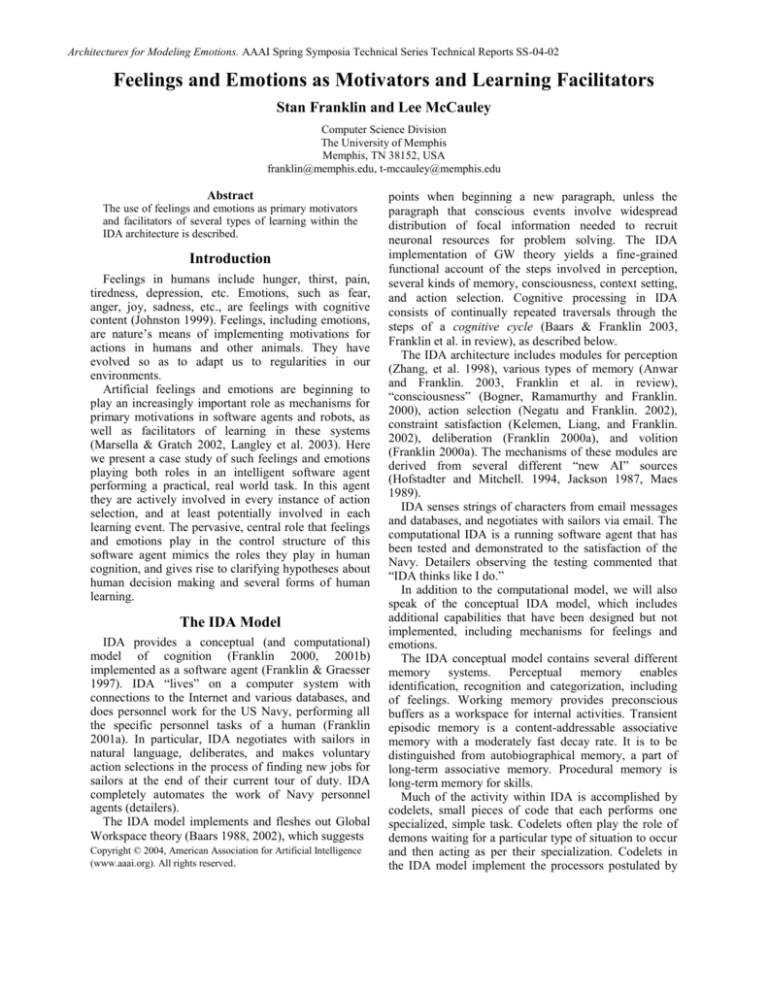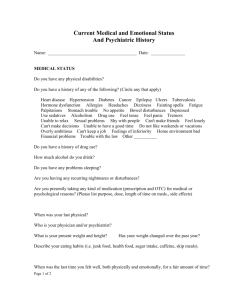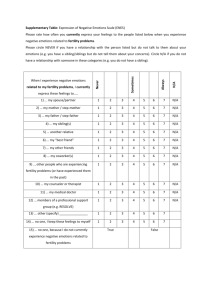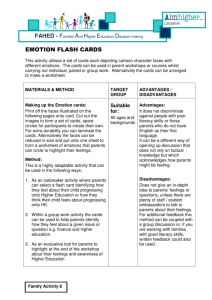
Architectures for Modeling Emotions. AAAI Spring Symposia Technical Series Technical Reports SS-04-02
Feelings and Emotions as Motivators and Learning Facilitators
Stan Franklin and Lee McCauley
Computer Science Division
The University of Memphis
Memphis, TN 38152, USA
franklin@memphis.edu, t-mccauley@memphis.edu
Abstract
The use of feelings and emotions as primary motivators
and facilitators of several types of learning within the
IDA architecture is described.
Introduction
Feelings in humans include hunger, thirst, pain,
tiredness, depression, etc. Emotions, such as fear,
anger, joy, sadness, etc., are feelings with cognitive
content (Johnston 1999). Feelings, including emotions,
are nature’s means of implementing motivations for
actions in humans and other animals. They have
evolved so as to adapt us to regularities in our
environments.
Artificial feelings and emotions are beginning to
play an increasingly important role as mechanisms for
primary motivations in software agents and robots, as
well as facilitators of learning in these systems
(Marsella & Gratch 2002, Langley et al. 2003). Here
we present a case study of such feelings and emotions
playing both roles in an intelligent software agent
performing a practical, real world task. In this agent
they are actively involved in every instance of action
selection, and at least potentially involved in each
learning event. The pervasive, central role that feelings
and emotions play in the control structure of this
software agent mimics the roles they play in human
cognition, and gives rise to clarifying hypotheses about
human decision making and several forms of human
learning.
The IDA Model
IDA provides a conceptual (and computational)
model of cognition (Franklin 2000, 2001b)
implemented as a software agent (Franklin & Graesser
1997). IDA “lives” on a computer system with
connections to the Internet and various databases, and
does personnel work for the US Navy, performing all
the specific personnel tasks of a human (Franklin
2001a). In particular, IDA negotiates with sailors in
natural language, deliberates, and makes voluntary
action selections in the process of finding new jobs for
sailors at the end of their current tour of duty. IDA
completely automates the work of Navy personnel
agents (detailers).
The IDA model implements and fleshes out Global
Workspace theory (Baars 1988, 2002), which suggests
Copyright © 2004, American Association for Artificial Intelligence
(www.aaai.org). All rights reserved.
points when beginning a new paragraph, unless the
paragraph that conscious events involve widespread
distribution of focal information needed to recruit
neuronal resources for problem solving. The IDA
implementation of GW theory yields a fine-grained
functional account of the steps involved in perception,
several kinds of memory, consciousness, context setting,
and action selection. Cognitive processing in IDA
consists of continually repeated traversals through the
steps of a cognitive cycle (Baars & Franklin 2003,
Franklin et al. in review), as described below.
The IDA architecture includes modules for perception
(Zhang, et al. 1998), various types of memory (Anwar
and Franklin. 2003, Franklin et al. in review),
“consciousness” (Bogner, Ramamurthy and Franklin.
2000), action selection (Negatu and Franklin. 2002),
constraint satisfaction (Kelemen, Liang, and Franklin.
2002), deliberation (Franklin 2000a), and volition
(Franklin 2000a). The mechanisms of these modules are
derived from several different “new AI” sources
(Hofstadter and Mitchell. 1994, Jackson 1987, Maes
1989).
IDA senses strings of characters from email messages
and databases, and negotiates with sailors via email. The
computational IDA is a running software agent that has
been tested and demonstrated to the satisfaction of the
Navy. Detailers observing the testing commented that
“IDA thinks like I do.”
In addition to the computational model, we will also
speak of the conceptual IDA model, which includes
additional capabilities that have been designed but not
implemented, including mechanisms for feelings and
emotions.
The IDA conceptual model contains several different
memory systems. Perceptual memory enables
identification, recognition and categorization, including
of feelings. Working memory provides preconscious
buffers as a workspace for internal activities. Transient
episodic memory is a content-addressable associative
memory with a moderately fast decay rate. It is to be
distinguished from autobiographical memory, a part of
long-term associative memory. Procedural memory is
long-term memory for skills.
Much of the activity within IDA is accomplished by
codelets, small pieces of code that each performs one
specialized, simple task. Codelets often play the role of
demons waiting for a particular type of situation to occur
and then acting as per their specialization. Codelets in
the IDA model implement the processors postulated by
Architectures for Modeling Emotions. AAAI Spring Symposia Technical Series Technical Reports SS-04-02
global workspace theory. Neurally they can be thought
of as cell assemblies or neuronal groups
(Edelman1987, Edelman and Tononi 2000). The
various sorts of codelets, perceptual, attentional,
behavioral, expectational, will be described below.
The Cognitive Cycle
The IDA model suggests a number of more
specialized roles for feelings in cognition, all
combining to produce motivations and to facilitate
learning. Here we describe IDA’s cognitive cycle in
nine steps, emphasizing the roles played by feelings
and emotions:
1. Perception. Sensory stimuli, external or
internal, are received and interpreted by
perception creating meaning. Note that this
stage is unconscious.
a. Early perception:
Input arrives
through
senses.
Specialized
perception codelets descend on the
input. Those that find features
relevant to their specialty activate
appropriate nodes in the slipnet (a
semantic net with activation).
b. Chunk perception: Activation passes
from node to node in the slipnet. The
slipnet stabilizes, bringing about the
convergence of streams from
different senses and chunking bits of
meaning into larger chunks. These
larger chunks, represented by
meaning nodes in the slipnet,
constitute the percept. Pertinent
feeling/emotions
are
identified
(recognized) along with objects and
their relations by the perceptual
memory system. This could entail
simple reactive feelings based on a
single input or more complex feelings
requiring the convergence of several
different percepts.
2. Percept to Preconscious Buffer. The percept,
including some of the data plus the meaning,
is stored in preconscious buffers of IDA’s
working memory. These buffers may involve
visuo-spatial , phonological, and other kinds
of information. Feelings/emotions are part of
the preconscious percept written during each
cognitive cycle into the preconscious working
memory buffers.
3. Local Associations. Using the incoming
percept and the residual contents of the
preconscious buffers as cues including
emotional content, local associations are
automatically retrieved from transient episodic
memory and from long-term associative
memory. The contents of the preconscious
buffers together with the retrieved local
associations from transient episodic memory
4.
5.
6.
and long term associative memory, roughly
correspond to Ericsson and Kintsch’s long-term
working memory (1995) and Baddeley’s
episodic buffer (2000). Feelings/emotions are
part of the cue that results in local associations
from transient episodic and declarative
memory. These local associations contain
records of the agent’s past feelings/emotions in
associated situations.
Competition for Consciousness. Attention
codelets, whose job it is to bring relevant,
urgent, or insistent events to consciousness,
view long-term working memory. Some of them
gather information, form coalitions and actively
compete for access to consciousness. The
competition may also include attention codelets
from a recent previous cycle. Present and past
feelings/emotions influence the competition for
consciousness in each cognitive cycle. Strong
affective content strengthens a coalition’s
chances of coming to consciousness.
Conscious Broadcast. A coalition of codelets,
typically an attention codelet and its covey of
related information codelets carrying content,
gains access to the global workspace and has its
contents broadcast. This broadcast is
hypothesized to correspond to phenomenal
consciousness. The conscious broadcast
contains the entire content of consciousness
including the affective portions. The contents of
perceptual memory are updated in light of the
current contents of consciousness, including
feelings/emotions, as well as objects, and
relations. The stronger the affect, the stronger
the encoding in memory. Transient episodic
memory is updated with the current contents of
consciousness, including feelings/emotions, as
events. The stronger the affect, the stronger the
encoding in memory. (At recurring times not
part of a cognitive cycle, the contents of
transient episodic memory are consolidated into
long-term declarative memory.) Procedural
memory (recent actions) is updated (reinforced)
with the strength of the reinforcement
influenced by the strength of the affect.
Recruitment of Resources. Relevant behavior
codelets respond to the conscious broadcast.
These are typically codelets whose variables can
be bound from information in the conscious
broadcast. If the successful attention codelet
was an expectation codelet calling attention to
an unexpected result from a previous action, the
responding codelets may be those that can help
to rectify the unexpected situation. Thus
consciousness solves the relevancy problem in
recruiting resources. The affective content
(feelings/emotions) together with the cognitive
content help to attract relevant resources
Architectures for Modeling Emotions. AAAI Spring Symposia Technical Series Technical Reports SS-04-02
(processors, neural assemblies) with which to
deal with the current situation.
7. Setting Goal Context Hierarchy. The
recruited processors use the contents of
consciousness, including feelings/emotions, to
instantiate new goal context hierarchies, bind
their variables, and increase their activation.
It’s here that feelings/emotions directly affect
motivation. They determine which terminal
goal contexts receive activation and how
much. It is here that feelings and emotions
most directly implement motivations by
helping to instantiate and activate goal
contexts. Other, environmental, conditions
determine which of the earlier goal contexts
receive additional activation.
8. Action Chosen. The behavior net chooses a
single behavior (goal context), perhaps from a
just instantiated behavior stream or possibly
from a previously active stream. This selection
is heavily influenced by activation passed to
various behaviors influenced by the various
feelings/emotions. The choice is also affected
by the current situation, external and internal
conditions, by the relationship between the
behaviors, and by the residual activation
values of various behaviors.
9. Action Taken. The execution of a behavior
(goal context) results in the behavior codelets
performing their specialized tasks, which may
have external or internal consequences. This is
IDA taking an action. The acting codelets also
include an expectation codelet (see Step 6)
whose task it is to monitor the action and to
try and bring to consciousness any failure in
the expected results.
We suspect that cognitive cycles occur five to ten
times a second in humans, overlapping so that some of
the steps in adjacent cycles occur in parallel (Baars, B.
J., and S. Franklin. 2003. How conscious experience
and working memory interact. Trends in Cognitive
Science 7:166-172.). Seriality is preserved in the
conscious broadcasts.
Related Work
The IDA architecture differs significantly from such
other cognitive architectures such as SOAR (Laird et
al. 1987) and ACT-R (Anderson & Lebiere 1998) in
that it is not a unified theory of cognition in the sense
of Newell (1990). Rather, its various modules are
implemented by a variety of different mechanisms
including the copycat architecture, sparse distributed
memory, pandemonium theory and behavior nets
(Franklin 2001b). Though the IDA architecture
contains no production rules and no neural networks, it
does incorporate both symbolic and connectionist
elements. The IDA architecture allows feelings and
emotions to play a central role in perception, memory,
“consciousness” and action selection as will be
described below. IDA’s “consciousness” mechanism,
based on Global Workspace theory, resembles a
blackboard system (Nii 1986), but there is much more to
the IDA architecture having to do with the interaction of
its various modules. This interaction is described in the
cognitive cycle detailed below.
The IDA architecture can be viewed as a specification of
the more general CogAff architecture of Sloman (Wright
et al. 1996). It has reactive and deliberative mechanisms
but, as yet, no meta-management. There is a superficial
resemblance between IDA and the ACRES system
(Moffat et al. 1993) in that both interact with users in
natural language. They are also alike in using emotions
to implement motivations. Rather than viewing emotions
as implementing motivations for the selection of actions
on the external environment, Marsella and Gratch study
their role in internal coping behavior (Marsella & Gratch
2002). From our point of view this is a case of emotions
implementing motivation for internal actions as also
occurs in the IDA conceptual model. The ICARUS
system also resembles a portion of the IDA conceptual
model in that it uses affect in the process of
reinforcement learning (Langley et al. 1991).
Conclusions
Being generated from order-of-magnitude one hundred
thousand lines of code, IDA is an exceedingly complex
software agent. Thus from the usefulness of artificial
feelings and emotions in the IDA architecture one would
not jump to the conclusion that they would play useful
roles in a more typical order-of-magnitude simpler
software agent or robotic control structure. Besides,
feelings and emotions are, as yet, only part of the IDA
conceptual model, and have not been implemented.
Significant difficulties could conceivably occur during
implementation. That artificial feelings and emotions
seem to play significantly useful roles in the conceptual
version of IDA’s cognitive cycles is not a conclusive
argument that they will do so in simpler, implemented
artificial autonomous agents.
Still, the IDA model suggests that software agents and
robots can be designed to use feelings/emotions to
implement motivations, offering a range of flexible,
adaptive possibilities not available to the usual more
tightly structured motivational schemes such as causal
implementation,
or
explicit
drives
and/or
desires/intentions.
So, what can we conclude? Note that the
computational IDA performs quite well with explicitly
implemented drives rather than with feelings and
emotions. It is possible that a still more complex
artificial autonomous agent with a task requiring more
sophisticated decision making would require them, but
we doubt it. Explicit drives seem likely to suffice for
quite flexible action selection in artificial agents, but not
in modeling biological agents. It appears that feelings
and emotions come into their own in agent architectures
requiring sophisticated learning. This case study of the
IDA architecture seems to suggest that artificial feelings
and emotions can be expected to be of most use in
software agents or robots in which online learning of
Architectures for Modeling Emotions. AAAI Spring Symposia Technical Series Technical Reports SS-04-02
facts and/or skills is of prime importance. If this
requirement were present, it would make sense to also
implement primary motivations by artificial feelings
and emotions.
References
Anwar, A., and S. Franklin. 2003. Sparse Distributed
Memory for "Conscious" Software Agents.
Cognitive Systems Research 4:339-354.
Anderson, J. R., and C. Lebiere. 1998. The atomic
components of thought. Mahwah, NJ: Erlbaum.
Baars, B. J. 1988. A Cognitive Theory of
Consciousness. Cambridge: Cambridge University
Press.
Baars, B. J. 2002. The conscious access hypothesis:
origins and recent evidence. Trends in Cognitive
Science 6:47–52.
Baars, B. J., and S. Franklin. 2003. How conscious
experience and working memory interact. Trends in
Cognitive Science 7:166–172.
Baddeley, A. D. 2000. The episodic buffer: a new
component of working memory? Trends in
Cognitive Science 4:417-423.
Bogner, M., U. Ramamurthy, and S. Franklin. 2000.
Consciousness" and Conceptual Learning in a
Socially Situated Agent. In Human Cognition and
Social Agent Technology, ed. K. Dautenhahn.
Amsterdam: John Benjamins.
Edelman, G. M. 1987. Neural Darwinism. New York:
Basic Books.
Edelman, G. M., and G. Tononi. 2000. A Universe of
Consciousness. New York: Basic Books.
Ericsson, K. A., and W. Kintsch. 1995. Long-term
working memory. Psychological Review 102:211245.
Franklin, S. 2000. Modeling Consciousness and
Cognition in Software Agents. In Proceedings of the
Third International Conference on Cognitive
Modeling, Groeningen, NL, March 2000, ed.
N. Taatgen. Veenendal, NL: Universal Press.
Franklin, S. 2000a. Deliberation and Voluntary Action
in ‘Conscious’ Software Agents. Neural Network
World 10:505-521.
Franklin, S. 2001a. Automating Human Information
Agents. In Practical Applications of Intelligent
Agents, ed. Z. Chen, and L. C. Jain. Berlin: SpringerVerlag.
Franklin, S.
2001b.
Conscious
Software:
A
Computational View of Mind. In Soft Computing
Agents: New Trends for Designing Autonomous
Systems, ed. V. Loia, and S. Sessa. Berlin: Springer
(Physica-Verlag).
Franklin, S., and A. C. Graesser. 1997. Is it an Agent,
or just a Program?: A Taxonomy for Autonomous
Agents. In Intelligent Agents III. Berlin: Springer
Verlag.
Franklin, S.,
B. J. Baars,
U. Ramamurthy,
and
M. Ventura. in review. The Role of Consciousness in
Memory. .
Hofstadter, D. R., and M. Mitchell. 1994. The Copycat
Project: A model of mental fluidity and analogymaking. In Advances in connectionist and neural
computation theory, Vol. 2: logical connections, ed. K.
J. Holyoak, and J. A. Barnden. Norwood N.J.: Ablex.
Jackson, J. V. 1987. Idea for a Mind. Siggart Newsletter,
181:23-26.
Johnston, V. S. 1999. Why We Feel:The Science of
Human Emotions. Reading MA: Perseus Books.
Kelemen, A., Y. Liang, and S. Franklin. 2002. A
Comparative Study of Different Machine Learning
Approaches for Decision Making. In Recent Advances
in Simulation, Computational Methods and Soft
Computing, ed. E. Mastorakis. Piraeus, Greece:
WSEAS Press.
Laird, E. J., A. Newell, and Rosenbloom P. S. 1987.
SOAR: An Architecture for General Intelligence.
Artificial Intelligence 33:1–64.
Langley, P., K. B. McKusick, J. A. Allen, W. F. Iba, and
K. Thompson. 1991. A design for the ICARUS
architecture. ACM SIGART Bulletin 2:104–109.
Langley, P., D. Shapiro, M. Aycinena, and M. Siliski.
2003. A value-driven architecture for intelligent
behavior. In Proceedings of the IJCAI-2003 Workshop
on Cognitive Modeling of Agents and Multi-Agent
Interactions.
Maes, P. 1989. How to do the right thing. Connection
Science 1:291-323.
Marsella, S., and J. Gratch; 2002. A Step Towards
Irrationality: Using Emotion to Change Belief. 1st
International Joint Conference on Autonomous Agents
and Multi-Agent Systems. Bologna, Italy. July 2002.
Moffat, D., N. H. Frijda, and R. H. Phaf. 1993. Analysis
of a computer model of emotions. In Prospects for
artificial intelligence, ed. A. Sloman, D. Hogg,
G. R. Humphreys A, and A. Ramsay. Amsterdam: IOS
Press.
Newell, A. 1990. Unified Theories of Cognition.
Cambridge MA: Harvard University Press.
Negatu, A., and S. Franklin. 2002. An action selection
mechanism for 'conscious' software agents. Cognitive
Science Quarterly 2:363-386.
Nii, H. P. 1986. The Blackboard Model of Problem
Solving and the Evolution of
Blackboard
Architectures. The AI Magazine Summer 1986:38–53.
Wright, I., A. Sloman, and L. Beaudoin. 1996. Towards a
Design-Based Analysis of Emotional Episodes.
Philosophy Psychiatry and Psychology 3:101–126.
Zhang, Z., S. Franklin, B. Olde, Y. Wan, and A.
Graesser. 1998. Natural Language Sensing for
Autonomous Agents. In Proceedings of IEEE
International Joint Symposia on Intellgence Systems
98.








